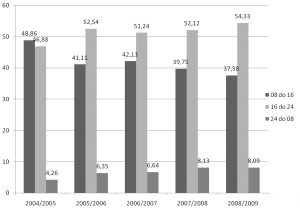The Learning Management System (LMS) of the Faculty of Transport and Traffic Sciences has been in operation since 2004 when it was developed for the studying purposes according to the German Fachhochschule study concept and according to the then specific characteristics of studying in the Republic of Croatia. The system consists of five own developed modules (DMS, SAN, e-Student, SMSCentar and FPZmobile) which in synergy form the Faculty LMS. The Document Management System (DMS) is a system of managing documents and processes used for authorized access of the Faculty staff members to the modules that control the work of computer laboratories, e-Learning system administration (publishing of teaching materials, control and assessment of seminar papers, etc.), as well as the module for managing documents and processes within the Faculty (orders for equipment, reports on malfunctions, updated on-line directory, etc.). The authorization and supervision system (SAN) is a set of technologies and applications that allow supervision of students’ work on computers in computer classrooms of the Faculty, and personalization of the working environment in the Windows operating system, regardless of the particular computer the student is using. The e-Student system allows students authorized access to the teaching materials, tasks, exercises and instructions. Apart from this the system provides support in applying and producing seminar papers and various forms of knowledge testing (e-Blic, e-Test, e-Kviz). The SMSCentar and SAN system with smsCRM application (Customer Relationship Management via SMS) open up the possibilities for a number of information services for students and Faculty staff members based on interactive communication by means of SMS messages. Some three years ago, the m-Learning module was added to the e-Learning system of the Faculty in the form of interactive application for real-time information of students via mobile terminal devices, called FPZmobile. The basic idea was to develop an application that will provide accurate and up-to-date information related to the Faculty and the students’ achievements (seminars, exercises, quizzes, etc.) during their studying, in a form suitable for browsing on the mobile terminal devices interface, such as mobile phones, PDA devices or Smartphones. The modularity of such a system allows fast implementation of the new services according to the ideas and suggestions expressed both by the teaching and the non-teaching staff, and the students.
In its five academic years of application, the e-Student module of the Faculty LMS has shown substantial positive shifts in the quality of studying. However, it also indicated substantial drawbacks both in the very processes of the system and in the technological obsoleteness and impossibilities of high-quality support of the Bologna Process and the program “Ishodi učenja na Sveučilištu u Zagrebu” (eng. “Learning Results at the University of Zagreb”). Currently the system is used at all Faculty courses, 509 of them for 7489 students and 362 Faculty staff members. In the previous years the students used the system somewhat less than 850,000 times and the teaching staff somewhat less than 50,000 times. A large number of published teaching materials, as many as 5645 files, is still substantially lower than the files created and published the most important system users: the students! They published as many as 16,000 topics for seminar papers and more than 15,000 seminar papers. The freedom that they have in using the LMS is being slowly accepted by the students and it has been noted that the students have started to use LMS more and more in the period from midnight till 8 o’clock in the morning, and less and less in the period from 8 a.m. to 4 p.m. as presented in Table 1. Table 1: Percentage of accessing LMS system per times of day
The negative sides of applying the Faculty LMS system and the drawbacks in the operation of the current system have to be reduced or completely eliminated in order to realize the desired level of studying quality. Therefore, a completely new system is to be designed and developed, based on the model presented in this paper. The new system will be adapted to the needs of studying according to the Bologna Process, harmonized with the project “Learning Results at the University of Zagreb”, the ISVU system, but also with the present trends in the technology of learning and communication among the students and between the students and the teachers. Moreover, the model proposed in this paper will provide guidelines for the development of the system according to the e-Learning 2.0 paradigm which encompasses all Web 2.0 tools in its operation such as Wiki, Blog, forums, social networking and others.
Authors: Vladimir Remenar, Dragan Perakoivć, Ivan Jovović
Book: New Trends in Technologies: Devices, Computer, Communication and Industrial Systems
Download: [wpfilebase tag=fileurl id=12 linktext=’Model Of The New LMS Generation With User-created Content’ /]
